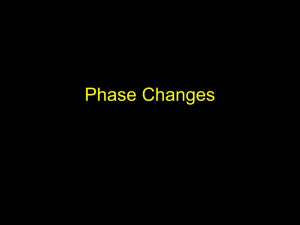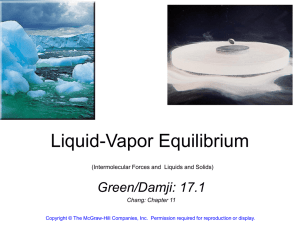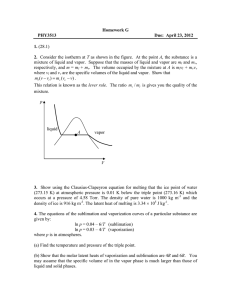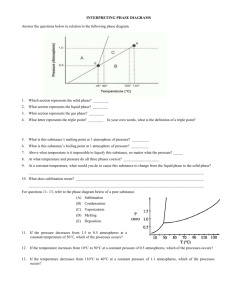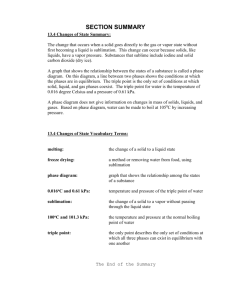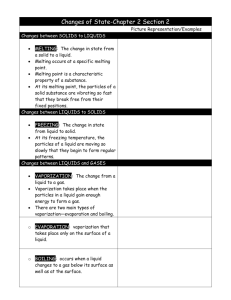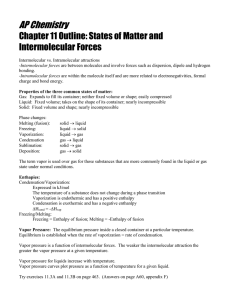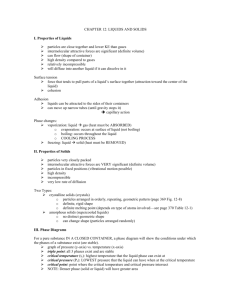States of Matter and Intermolecular Forces
advertisement
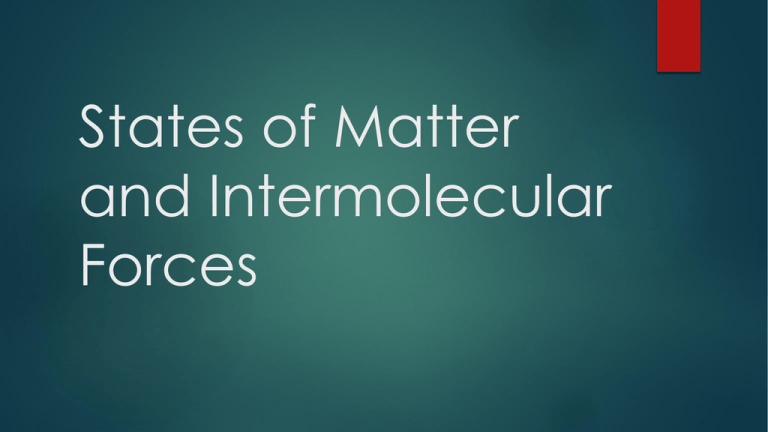
States of Matter and Intermolecular Forces 3 Phases of Matter Solid Liquid Gas How do particles move in a solid? Solids Have a definite shape/structure Very little particle movement—fixed position Liquids Limited structure to particles Movement is less restricted, particles can move around and collide with each other Conform to a container’s shape Gases No structure Movement is not restricted Particles are always in motion Expansion occurs Phase Changes Physical change of a chemical compound Change of state Types: Melting Freezing Vaporization Condensation Sublimation Deposition Evaporation/Vaporization Liquid---gas, endothermic Liquid molecules gain enough energy to enter the gaseous state via breaking intermolecular forces. Enthalpy of vaporization— Amount of heat necessary to evaporate a liquid at constant temperature kJ/mole Table 11.1 (p. 435) Condensation Gas-----liquid Exothermic process Example 1 At 25°C, how much heat is required to evaporate 175 g of methanol? Example 2: Which liquid in Table 11.1 (p. 435) requires the lowest amount of heat for vaporization? Vaporization/Condensation Processes exist at the same time Dynamic equilibrium is established Rate of vaporization = rate of condensation No net change in molecular movement Many factors determine how long it will take for equilibrium to be established Vapor Pressure Characteristic of liquid Partial pressure of vapor when it exists with a liquid in dynamic equilibrium under constant temperature Dependent on liquid type and temperature at equilibrium INCREASE vapor pressure of liquid, INCREASE temperature Vapor Pressure Curve Figure 11.4 p. 439 Volatile vs. Nonvolatile Liquids 1) 2) Volatile Liquids WEAK intermolecular forces High vapor pressure Ex. Gasoline, alcohols, “Whoosh Bottle” Nonvolatile Liquids STRONG intermolecular forces Low vapor pressure Whoosh Bottle Demo Video http://www.youtube.com/watch?v=-BtFHg-lm_M Boiling Point Liquid characteristic Vaporization present throughout the liquid Point where vapor pressure = atmospheric pressure Aids in liquid identification Decrease atmospheric pressure with increased altitude, lowers boiling point Boiling Point (cont.) Critical temperature/pressure (TC , PC) Highest temperature with liquid and vapor present as physically different states in equilibrium Point where increased pressure only will result in condensation Critical Point Actual physical condition where critical temperature and pressure achieved Melting/Melting Point Melting/freezing point Temperature when solid “melts” Temperature when liquid becomes solid For water = _________ Enthalpy (heat) of fusion– Δhfusion Amount of heat needed to convert a certain amount of a solid to a liquid Melting—endothermic Freezing—exothermic (- value) Cooling/Heating Curves Figure 11.7 p. 444 Cooling/Heating Curves Sublimation Solid Gas Some solid compounds are volatile enough to have a vapor pressure and convert to gas Ex. Mothballs, dry ice Rate of sublimation = rate of deposition Sublimation curve Sublimation pressure— Pressure of a vapor existing in equilibrium with a solid Enthalpy (heat) of sublimation = ΔHfusion + ΔHvapn Homework Chemical Bonding Study Guide Intermolecular Forces II Worksheet—due Friday

